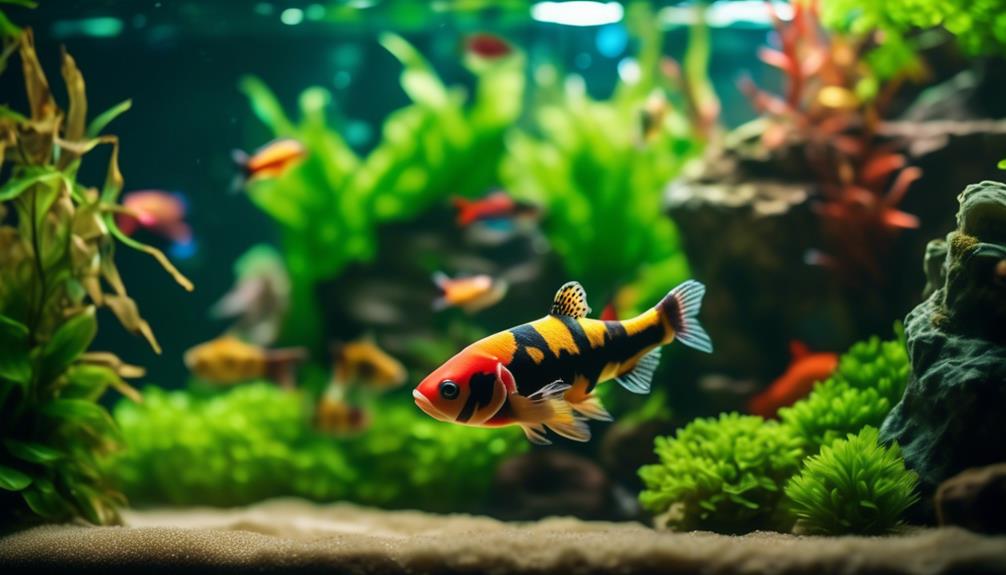Welcome to the enchanting world of colorful clown loaches, where vibrant hues and captivating behavior come together to create a truly mesmerizing aquatic display.
Originating from the western islands of Indonesia, these freshwater fish have become the darlings of aquarium enthusiasts, thanks to their striking appearance and entertaining antics.
With their brilliant red-orange fins, contrasting yellow-tan bodies, and distinct black bands, clown loaches effortlessly steal the show. But there is more to these aquatic showstoppers than meets the eye.
From their unique sleeping positions to the intriguing clicking sounds they make, clown loaches are an endless source of fascination.
In this article, we will explore the secrets of their origins, offer valuable insights on creating the perfect aquarium environment, delve into their dietary needs, and provide expert tips on their care and breeding.
Get ready to dive into the captivating world of colorful clown loaches, where every discovery promises to leave you wanting more.
Key Takeaways
- Clown loaches are a colorful and unique species of fish originating from Indonesia.
- They exhibit playful and clown-like behavior, making them entertaining to observe.
- Proper care includes providing the right tank size, temperature, and hiding places.
- Their diet should consist of protein-rich foods and they can help control snail infestations.
Origins and Appearance
The Clown Loach (Chromobotia macracanthus) is a freshwater fish that originates from the western islands of Indonesia and is recognized for its vibrant and eye-catching appearance. It inhabits slow-moving rivers and streams with sandy or muddy bottoms, as well as flooded forests during the rainy season.
The natural habitat of the Clown Loach provides it with a diverse array of colors to help it blend in and avoid predators. Its body is typically yellow-tan in color, adorned with three prominent black bands that run horizontally along its sides. The fins of the Clown Loach are bright red-orange, adding a striking contrast to its overall appearance. It is worth noting that the colors of Clown Loaches may fade as they age, with older individuals exhibiting a more subdued and less vibrant coloration.
Understanding the natural habitat and color variations of the Clown Loach is essential for creating an environment that mimics its native conditions and allows it to thrive in captivity.
Setting Up the Perfect Aquarium
To ensure optimal conditions for the Clown Loach in captivity, careful consideration must be given to setting up an aquarium that replicates its natural habitat. Creating the perfect environment involves various factors, including aquarium decoration and a well-designed filtration system.
- Aquarium Decoration: The presence of suitable hiding places, such as rocks, caves, and driftwood, is essential for clown loaches to feel secure. These decorations mimic their natural habitat, providing them with places to retreat and explore. Additionally, live plants can be incorporated to create a more natural and aesthetically pleasing environment.
- Filtration System: A high-quality filtration system is crucial for maintaining water quality and ensuring the well-being of clown loaches. The filtration system should include mechanical, biological, and chemical filtration to remove debris, harmful substances, and maintain nitrogen cycle stability. It is recommended to choose a filter that is appropriate for the size of the aquarium and the number of clown loaches.
Nourishing Their Appetites

Clown loaches require a diverse and protein-heavy diet to meet their nutritional needs and promote their overall health and well-being. Their feeding habits consist of scavenging the floor of the aquarium for leftover food using their barbels.
In order to provide a balanced diet, it is recommended to feed them a variety of foods such as mollusks, bloodworms, tubifex worms, and sinking pellets. Additionally, they enjoy eating blanched zucchini slices and Repashy gel food.
Clown loaches can also help control snail infestations by eating snails. When considering tank mates, it is important to avoid putting them with small fish or invertebrates that can fit in their mouths. However, adding schooling fish as dither fish can encourage clown loaches to come out of hiding and showcase their unique behavior.
Breeding and Reproduction
Breeding and reproduction in clown loaches involve distinct characteristics and environmental factors that contribute to successful mating and the survival of their offspring. To shed light on this fascinating process, let's explore some key aspects:
- Breeding techniques:
Clown loaches are egg scatterers, meaning they release their eggs throughout the aquarium. To encourage successful breeding, provide them with suitable conditions such as cooler temperatures, lower pH levels, and softer water. It is crucial to remove the eggs promptly to prevent them from being eaten by the adults.
- Reproduction challenges:
One of the main challenges in breeding clown loaches is ensuring the survival of the fry. Newly hatched clown loaches are tiny and require specific food sources such as live baby brine shrimp or micro worms. Additionally, maintaining optimal water quality and providing a well-balanced diet is essential for the overall health and growth of the fry.
Understanding the breeding techniques and overcoming reproduction challenges are crucial for those interested in successfully breeding clown loaches and contributing to the preservation of this captivating species.
Expert Tips for Clown Loach Care

Understanding the intricacies of caring for clown loaches requires a comprehensive knowledge of their unique behaviors and specific requirements in order to ensure their well-being in a captive environment.
When choosing tank mates for clown loaches, it is important to consider their peaceful nature and avoid putting them with small fish or invertebrates that can fit in their mouths. Suitable tank mates include other peaceful and medium-sized fish such as tetras, rasboras, and larger barbs.
Additionally, it is crucial to be aware of common diseases in clown loaches, such as ich (white spot disease) and skin flukes. Regular water parameter testing, maintaining good water quality, and providing a balanced diet can help prevent these diseases.
Quarantining new fish and ensuring proper acclimation are also essential steps in maintaining the health of clown loaches.
Frequently Asked Questions
How Long Do Clown Loaches Typically Live?
The average lifespan of clown loaches is around 10-15 years. However, several factors can affect their lifespan, including water quality, diet, tank size, and overall care. Providing optimal conditions and meeting their specific needs can contribute to a longer lifespan.
Can Clown Loaches Be Kept With Other Types of Fish?
Clown loaches can be kept with other fish, but compatibility depends on the size and temperament of the tankmates. Avoid small fish or invertebrates that can fit in their mouths. Consider adding schooling fish as dither fish to encourage clown loaches to come out of hiding.
Do Clown Loaches Require a Specific Type of Substrate in Their Tank?
Clown loaches do not require a specific type of substrate in their tank. However, it is recommended to use a soft, sandy substrate to mimic their natural habitat. This will also prevent any damage to their delicate barbels.
Are Clown Loaches Prone to Any Specific Health Issues?
Clown loaches are prone to several common health issues, including ich, fin rot, and bacterial infections. Effective treatments include raising the water temperature, adding aquarium salt, and using medications specifically formulated for freshwater fish diseases.
How Large Can Clown Loaches Grow in Captivity?
In captivity, clown loaches can grow up to 12 inches (30 cm) in length. They require a protein-heavy diet consisting of mollusks, bloodworms, and sinking pellets. Breeding occurs best in cooler temperatures, lower pH, and softer water conditions.
Conclusion
In conclusion, colorful clown loaches are visually stunning freshwater fish that have gained popularity among aquarium enthusiasts for their striking appearance and entertaining behavior.
Originating from the western islands of Indonesia, these loaches exhibit fascinating clown-like antics and possess the ability to pick up objects with their mouth while being chased by their fellow loaches.
An interesting statistic is that clown loaches can live up to 20 years in captivity, making them a long-term investment for aquarium enthusiasts.

